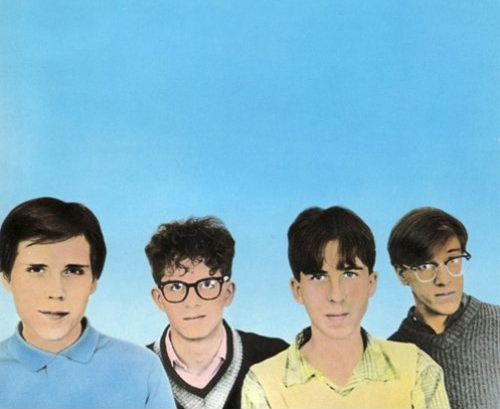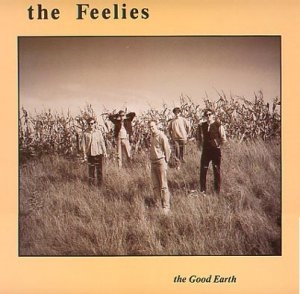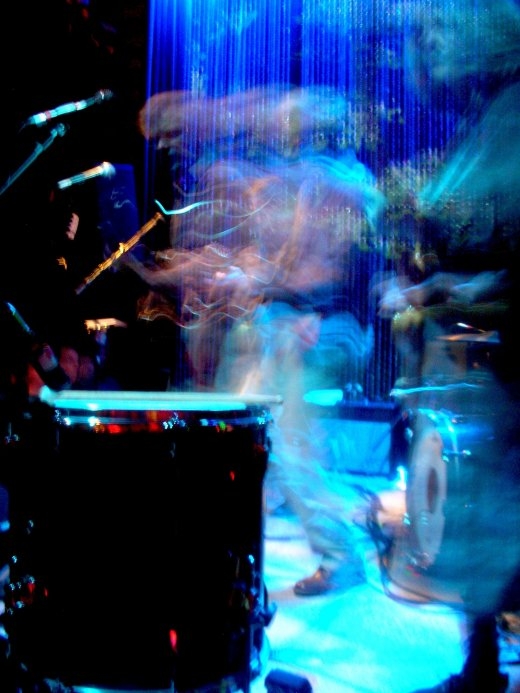
Now playing on PHAWKER RADIO! Because it’s the best record you never heard.
 VILLAGE VOICE: Though we may be the lone strangers on this one, companion-less contrarians careless of the compulsory crit-pick of Crazy Rhythms, likely the only thing writer Rick Moody and I have in common is our commitment of needle to the Feelies’ Good Earth vinyl over a thousand times apiece. Easy. This, the band’s second album — released in 1986, a good half-dozen years after their debut, Crazy Rhythms — served as the soundtrack to Moody’s own novelistic debut, 1992’s Garden State. (No, not that Garden State. This Garden State is set in Hoboken and bereft of anyone remotely resembling Natalie Portman.) Like the book Moody wrote while playing it over and over and over, the Feelies’ sophomore effort — thanks to vocals so buried they might’ve reached China — reeks of the now-removed warehouse-industrial side of Ol’ Blue Eyes’ hometown. Mellifluous, yet murky. As if singing a sprightly shadow. The album (nominally co-produced by R.E.M. guitarist Peter Buck) not only bridged the gap from the Velvet Underground to college radio, it also paved the way for Hoboken geek rock (They Might Be Giants, Yo La Tengo, etc.). And while I’m not suggesting this is a good thing, the multi-platinum equation that was the Counting Crows’ August and Everything After is near-equal parts Van Morrison (vocals) and the Feelies (music). MORE
VILLAGE VOICE: Though we may be the lone strangers on this one, companion-less contrarians careless of the compulsory crit-pick of Crazy Rhythms, likely the only thing writer Rick Moody and I have in common is our commitment of needle to the Feelies’ Good Earth vinyl over a thousand times apiece. Easy. This, the band’s second album — released in 1986, a good half-dozen years after their debut, Crazy Rhythms — served as the soundtrack to Moody’s own novelistic debut, 1992’s Garden State. (No, not that Garden State. This Garden State is set in Hoboken and bereft of anyone remotely resembling Natalie Portman.) Like the book Moody wrote while playing it over and over and over, the Feelies’ sophomore effort — thanks to vocals so buried they might’ve reached China — reeks of the now-removed warehouse-industrial side of Ol’ Blue Eyes’ hometown. Mellifluous, yet murky. As if singing a sprightly shadow. The album (nominally co-produced by R.E.M. guitarist Peter Buck) not only bridged the gap from the Velvet Underground to college radio, it also paved the way for Hoboken geek rock (They Might Be Giants, Yo La Tengo, etc.). And while I’m not suggesting this is a good thing, the multi-platinum equation that was the Counting Crows’ August and Everything After is near-equal parts Van Morrison (vocals) and the Feelies (music). MORE
WE KNOW IT’S ONLY ROCK N’ ROLL BUT WE LIKE IT

SLIPPING INTO SOMETHING: The Feelies, JB’s, Friday [Photo: JONATHAN VALANIA]
![]() BY JONATHAN VALANIA FOR THE INQUIRER The Feelies are one of those beloved band’s bands whose influence far exceeds their royalty statements and, as a consequence, the period on the last sentence in their bio keeps turning into a comma. Borne of the suburban garages of North Haledon, New Jersey, they released Crazy Rhythms in 1980 to massive acclaim and minimal sales and then promptly split off into a myriad of minor side projects, only to resurface again in 1986 with the altogether wonderful The Good Earth, produced by Peter Buck, guitarist for REM, whose early sound is deeply indebted to the inviting ambiguities and pretty persuasions of the Feelies’ aesthetic.
BY JONATHAN VALANIA FOR THE INQUIRER The Feelies are one of those beloved band’s bands whose influence far exceeds their royalty statements and, as a consequence, the period on the last sentence in their bio keeps turning into a comma. Borne of the suburban garages of North Haledon, New Jersey, they released Crazy Rhythms in 1980 to massive acclaim and minimal sales and then promptly split off into a myriad of minor side projects, only to resurface again in 1986 with the altogether wonderful The Good Earth, produced by Peter Buck, guitarist for REM, whose early sound is deeply indebted to the inviting ambiguities and pretty persuasions of the Feelies’ aesthetic.
Two major label releases would follow — 1988’s Only Life and 1991’s Time For A Witness — and that was pretty much all she wrote. Although a funny thing happened on the way to the cut-out bin in that The Feelies pretty much wrote the template for much of the indie rock that would follow: A dense web of jangling guitars and zooming raga-like drones, percussion-heavy rhthyms played at double latte tempos, incantatory lead vocals mixed as understatement of the year.
Fast forward to 2008, when the reactivated Feelies once again turned the period at the end of their bio into a comma. Friday night at Johnny Brendas the band was living proof that not much has really changed all these years later. They still dress like grad studies professors, with dual frontmen/guitarists Bill Million and Glenn Mercer rocking matching pleated khakis.
They still love turning a good classic rock cover sideways (“She Said, She Said” and “Paint It Black), crazy-tempoed rave-ups like “Slipping (Into Something)” have lost none of their amphetamine pep, and the Feelies’ brand of indie-rock raga can still make a sold out club audience wiggle wildly like worms on a hook despite the preponderance of graybeards and thinning pates in the crowd. With a set list that drew liberally from their glorious middle period, the Feelies recreated once-upon-a-time college radio staples such as “The High Road” and “Deep Fascination” with impeccable precision, warmth and clarity, not to mention that sense of mystery at the center of their music that always suggested they knew much more than they let on.
